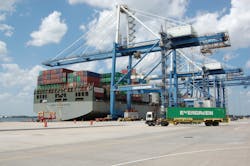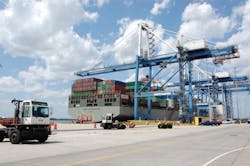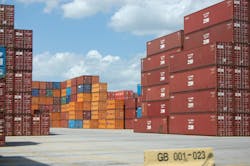Trucking still projected to benefit from wider Panama Canal
There still seems to be a lot of optimism surrounding the benefits the $5 billion-plus Panama Canal expansion project can deliver to trucking – especially in terms of a shift in freight flows from the U.S. West Coast to the U.S. East Coast, though said shift is taking a while to develop.
“While the West Coast still handles about half of all shipping volume, the East Coast is seeing significant growth,” noted Walter Kemmsies, managing director, economist and chief strategist of the port, airport and global infrastructure (PAGI) group at consulting firm JLL Inc.
“The trans-Pacific trade lane is the largest in the U.S. by overall volume, so West Coast ports are still in high demand,” he explained in a statement. “But little room to build distribution centers near these ports, coupled with pressure to move cargo from the first to last mile, presents challenges for the future.”
Kemmsies’ comments stem from a new report compiled by JLL that shows that while West Coast port markets remain “naturally competitive,” especially in terms of handling U.S.-Asian trade, demand is escalating around East Coast and Gulf Coast ports.
Since 2013, for example, Mid-Atlantic and Southeastern seaports have seen a 20% hike in volumes compared to just 5% on the West Coast, Kemmsies explained; growth attributed to the expanded Panama Canal, increased trade with Asia, and importers progressively pursuing a “four-corner” strategy throughout the coasts for cost saving and risk control.
David Parker, chairman, president and CEO of TL carrier Covenant Transport, noted in his company’s second quarter earnings call that a freight shift of sorts began two years ago to New Jersey, Baltimore, MD, and Virginia ports from California and that is generating more outbound demand from eastern seaboard states.
“[The port of] Savannah [GA] just in the last year continues to explode. It continues to get big and it is really taking a lot of pressure off the state of Florida, which we all know is a bad outbound area,” he said during Covenant’s call.
“I am excited about what’s happening on Savannah and what it’s going to do to the south [and] I am thrilled about what’s happening [to] the East Coast ports,” Parker added.
So far, predictions are that a 10% shift in ocean freight from the Asian U.S. shipping route while shift over to Eats Coast ports due to the wider Panama Canal by 2020 and Parker for one thinks that will still occur.
Mark Marinko, CFO for Great Lakes Dredge & Dock Corp., provided further insight into this freight shift from a different perspective – from that of rising demand for expansion projects at East Coast ports.
“We can tell you expect to see ports along the East Coast pursue deepening projects in the next few years,” he said during a conference call with analysts back in May. “Many of the projects are progressing nicely and we are encouraged at the state and local governments are acknowledging their important roles in facilitating investment in federal projects.”
Marinko noted that there are currently seven states with “active legislation” to begin or improve funding for port and coastal work including Texas, Louisiana, Florida, South Carolina, North Carolina, New Jersey, and Connecticut.
“It still appears that Jacksonville [FL] will likely be the next port that tenders a bid now most likely in the third quarter of this year,” he added.
The JLL PAGI Seaport Outlook 2017 believes five major trends are starting to take shape that are being driven by the expanded Panama Canal, several of which impact trucking:
“So far in 2017, all port markets across the U.S. have seen robust growth,” added Mark Levy, Executive Managing Director and leader of JLL’s PAGI group. “But over the last two years, East Coast ports – including New York/New Jersey and Jacksonville – have seen the largest decline in [real estate] vacancy rates.”
About the Author
Fleet Owner Staff
Our Editorial Team
Kevin Jones, Editorial Director, Commercial Vehicle Group
Cristina Commendatore, Executive Editor
Scott Achelpohl, Managing Editor
Josh Fisher, Senior Editor
Catharine Conway, Digital Editor
Eric Van Egeren, Art Director


